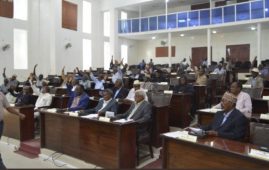Jonathan R. Wakely – an associate at Covington & Burling LLP and a former a political analyst of the Central Intelligence Agency published the following brief commentary on the National Law Review this week.
By any measure Ethiopia is experiencing impressive economic growth. According to IMF data, GDP grew 8.7 percent in 2012, the country’s weakest year since 2009. In 2010, GDP grew a blistering 12.6 percent, higher than all but a handful of countries worldwide. Going forward, the IMF estimates Ethiopia’s economy will grow at 8.0 to 8.5 percent in the upcoming fiscal years. Ethiopia’s Finance Ministry is even more bullish, predicting 11 and 11.4 percent growth in the next two fiscal years. 
As Ethiopia’s economy grows, so too do its energy demands. Fortunately, Ethiopia is also blessed with some of the world’s greatest renewable energy resources. As of 2010, nearly 90 percent of installed energy capacity came from hydroelectric power, and some estimates of the country’s total hydropower potential exceed 45,000MW, second in Africa only to the Democratic Republic of the Congo. Despite this potential, Ethiopia has remained a net energy importer. That may be set to change.
In Ethiopia’s northernmost region, close to the border with Sudan, a new structure is rising on the Blue Nile river that will shape Ethiopia’s — and East Africa’s — energy future: the Grand Ethiopian Renaissance Dam. Its name is not modest, but neither is its potential impact. Currently about 30 percent complete, the dam will become Africa’s largest, producing an estimated 6,000MW of electricity. Ethiopia is largely funding the $4.7 billion project itself, through a combination of bonds and taxes.
There is no doubt that Ethiopia’s stunning growth is fueling its energy ambitions, including the ambitious Renaissance Dam project. But it is not unreasonable to think that the Renaissance Dam itself will further drive Ethiopia’s growth. The project has already created more than 10,000 jobs. Moreover, a recent study of East Africa energy experts concluded that hydroelectric power provided the greatest potential to close the region’s energy gap — nearly two thirds of Africans have no access to electricity — and recommended greater investment.
To be sure, the project has not been without controversy. Egypt and Sudan have expressed concern that the dam with have detrimental downstream effects, including to agriculture. While relations have been icy since Ethiopia started construction in May 2013, the parties are continuing to work through the outstanding issues: a fourth round of tripartite was held last month in Khartoum.
Ethiopia’s torrid growth cannot continue forever, but if the Renaissance Dam is as successful as predicted, it is hard to see how the view from Addis Ababa will not be bright.
******
*Originally published on National Law Review on Sept. 17, 2014, titled “Ethiopia’s Grand Renaissance – Steady Economic Growth”, authored by Jonathan Wakely who is an associate at Covington & Burling LLP and advises clients on a range of significant international trade, national security, and public policy matters. He previously served as a political analyst with the Central Intelligence Agency, where he provided strategic analysis to the President and other senior policymakers.





